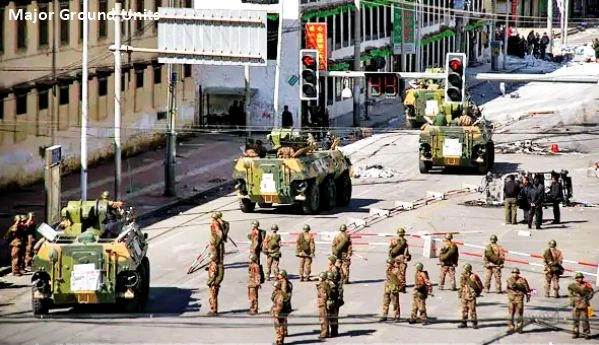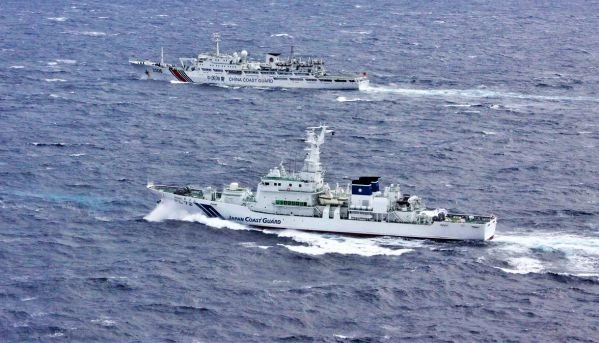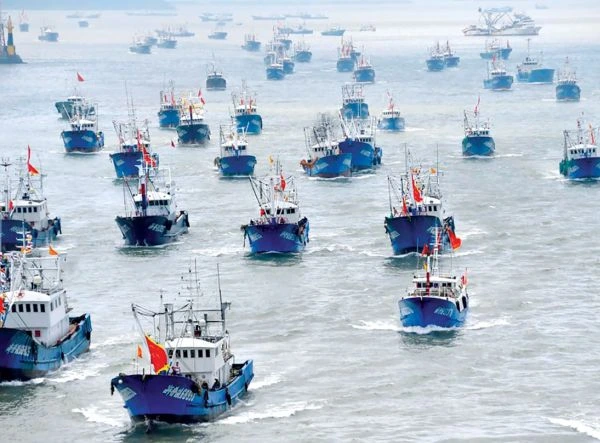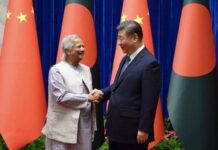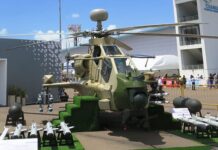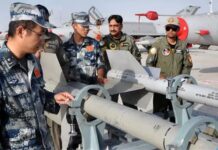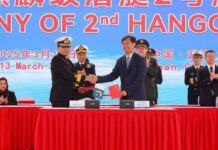Key Takeaway
• Interoperability and integration between the PLA, its reserve components, and the PRC’s paramilitary forces continues to grow in scale and sophistication, including the coordination between the PLAN, the China Coast Guard (CCG), and the People’s Armed Forces Maritime Militia (PAFMM).
People’s Liberation Army Reserve Force. The PLA Reserve Force was founded in 1983 and professionalized throughout the 1990s and 2000s. On July 1, 2020, the PRC amended laws, regulations, and policies to bring the Reserve Force under the command of the Central Committee of the CCP and the CMC. The previous arrangement split control of the Reserve Force between the PLA and local Party committees. Motivations for the change include improving combat capability, facilitating cooperation with active-duty units, and upholding the CCP’s absolute leadership over the military. Chinese sources often stated specifically that the reform would enhance reserve performance in Tibet and Xinjiang. Additionally, the PLA appears to have begun making a partial restructure towards using a PLAA reserve base system to continue to improve facilitation and support for active-duty units.
The PLA Reserve Force is comprised of approximately 510,000 personnel subordinate to the Army Reserve, Navy Reserve, Air Force Reserve, and Rocket Force Reserve. According to official Chinese media and journal articles, a small number of active duty cadre serve as a permanent backbone for the Reserve Force to enable the influx of reserve officers and soldiers when required. The 2020 Science of Military Strategy published by the PLA’s National Defense University states the building of the reserve force is an important part of national defense construction and is the basic and strategic project to consolidate national defense. The primary mission of the reserves is to reinforce active-duty forces for national defense, with a secondary mission to aid in national disasters or maintaining social order. The Reserve Force should be prepared to effectively respond to a variety of emergencies and military threats, safeguard national sovereignty, security and development interests, and the core security of the country.
Reserve officers are selected from veteran PLA officers, local officials, PAP or militia officers, and other technical personnel. Reserve soldiers are selected from eligible PLA veterans, trained grass-roots militias, and other local or military specialty personnel. Some reserve soldiers also failed to meet active duty entry requirements and conduct remedial training in the reserves until they are able to join the active duty force.
Anecdotal evidence suggests that significant issues remain in the mobilization of reserve forces, including which equipment should be used, what level of government pays for the mobilization, and resistance from enterprises at the sudden requisition of their employees. Chinese documents state that Reserve Force equipment is predominately antiquated; one report stated that more than 70% of air defense artillery and artillery equipment is at or beyond its maximum service life. Some of the equipment is no longer manufactured and repair requires cannibalization.
The PLA Reserve Force also provides significant support to local areas after natural disasters. The PLA Reserve Force does not include militias, the Civil Air Defense, or myriad other groups (e.g. the People’s Armed Police or the Xinjiang Production and Construction Corps (XPCC)).
People’s Armed Police (PAP). The PAP is a component of the PRC’s armed forces and an armed wing of the CCP with an estimated 660,000 personnel. In the 2020 National Defense University publication Science of Military Strategy, the primary responsibilities of the PAP include maintaining political, institutional and regime security, handling emergency rescue, counter-terrorism, air support, maritime rights protection, administrative law enforcement, and defense operations. The PAP is organized into three main parts: the Internal Security Corps, the Mobile Corps, and the China Coast Guard (CCG). The Internal Security Corps covers each of the PRC’s provinces, provincial-level cities, and autonomous regions. There is not yet a reported permanent presence of the PAP in the Special Administrative Regions (SARs) of Hong Kong or Macao, but since 2019, the PAP maintains a rotational deployment in Hong Kong. The Mobile Corps is comprised of myriad PAP units placed to reinforce the
Internal Security Corps and provide flexibility in responding to internal security issues. Mobile Corps units are concentrated in the west and south (Xinjiang, Tibet, Sichuan, Yunnan, and Qinghai) as well as the major cities of Beijing and Shanghai. Xinjiang is a particular focus of the PAP due to PRC perceived separatist activity, as well as its proximity to areas of unrest in Central Asia. The China Coast Guard is covered in depth in the next section of this report.
Xi Jinping and the CCP leadership tasked the PAP with integrating themselves into the PLA’s joint operation system. The PAP’s main mission is internal security, but is increasingly focused on joint operations with the PLA and is developing capabilities for rapid response, mobility, and counterterrorism operations. The PAP also conducts training with foreign partners, including at least Uzbekistan, Kyrgyzstan, and Russia. Since at least 2016, PAP forces have likely operated in Tajikistan, patrolling the tri-border region connecting Tajikistan, Afghanistan, and the PRC.
In 2021, the PAP reportedly executed numerous emergency rescue and disaster response operations in response to heavy flooding and typhoons, as well as conducting counter- terrorism and opposing force training and exercises.
China Coast Guard (CCG). The CCG is subordinate to the PAP and is responsible for a wide range of maritime security missions, including defending the PRC’s sovereignty claims; fisheries enforcement; combating smuggling, terrorism, and environmental crimes; as well as supporting international cooperation. In 2021, the Standing Committee of China’s National People’s Congress passed the Coast Guard Law which took effect on 1 February 2021. The legislation regulates the duties of the CCG, to include the use of force, and applies those duties to seas under the jurisdiction of the PRC. The law was met with concern by other regional countries that may perceive the law as an implicit threat to use force, especially as territorial disputes in the region continue.
The CCG’s rapid expansion and modernization has made it the largest maritime law enforcement fleet in the world. Its newer vessels are larger and more capable than older vessels, allowing them to operate further off shore and remain on station longer. A 2019 academic study published by the U.S. Naval War College estimates the CCG has over 140 regional and oceangoing patrol vessels (of more than 1,000 tons displacement). Some of the vessels are former PLAN vessels, such as corvettes, transferred to the CCG and modified for CCG operations. The newer, larger vessels are equipped with helicopter facilities, high- capacity water cannons, interceptor boats, and guns ranging from 20 to 76 millimeters. In addition, the same academic study indicates the CCG operates more than 120 regional patrol combatants (500 to 999 tons), which can be used for limited offshore operations, and an additional 450 coastal patrol craft (100 to 499 tons).
China’s Maritime Militia
Background & Missions. The People’s Armed Forces Maritime Militia (PAFMM) is a subset of China’s national militia, an armed reserve force of civilians available for mobilization that is ultimately subordinate to the Central Military Commission through the National Defense Mobilization Department. Throughout China, militia units organize around towns, villages, urban sub-districts, and enterprises, and vary widely in composition and mission.
PAFMM vessels train with and assist the People’s Liberation Army Navy (PLAN) and the China Coast Guard (CCG) in tasks such as safeguarding maritime claims, surveillance and reconnaissance, fisheries protection, logistics support, and search and rescue. China employs the PAFMM in gray zone operations, or “low-intensity maritime rights protection struggles,” at a level designed to frustrate effective response by the other parties involved. China employs PAFMM vessels to advance its disputed sovereignty claims, often amassing them in disputed areas throughout the South and East China Seas. In this manner, the PAFMM plays a major role in coercive activities to achieve China’s political goals without fighting, and these operations are part of broader Chinese military theory that sees confrontational operations short of war as an effective means of accomplishing strategic objectives.
Operations. PAFMM units have been active for decades in maritime incidents and combat operations throughout China’s near seas and in these incidents PAFMM vessels are often used to supplement CCG cutters at the forefront of the incident, giving the Chinese the capacity to outweigh and outlast rival claimants. In March of 2021, hundreds of Chinese militia vessels moored in Whitsun Reef, raising concerns the Chinese planned to seize another disputed feature in the Spratly Islands. Other notable incidents include standoffs with the Malaysian drill ship West Capella (2020), defense of China’s HYSY-981 oil rig in waters disputed with Vietnam (2014), occupation of Scarborough Shoal (2012), and harassment of USNS Impeccable and Howard O. Lorenzen (2009 and 2014). Historically the maritime militia also participated in China’s offshore island campaigns in the 1950s, the 1974 seizure of the Paracel Islands from South Vietnam, and the occupation of Mischief Reef in the Spratly Islands in 1994.
The PAFMM also protects and facilitates PRC fishing vessels operating in disputed waters. For example, from late December 2019 to mid-January 2020, a large fleet of over 50 PRC fishing vessels operated under the escort of multiple China Coast Guard patrol ships in Indonesian claimed waters northeast of the Natuna Islands. At least a portion of the PRC ships in this fishing fleet were affiliated with known traditional maritime militia units, including a maritime militia unit based out of Beihai City in Guangxi province. While most traditional maritime militia units operating in the South China Sea continue to originate from townships and ports on Hainan Island, Beihai is one of a number of increasingly prominent maritime militia units based out of provinces in the PRC. These mainland based maritime militia units routinely operate in the Spratly Islands and in the southern South China Sea, and their operations in these areas are enabled by increased funding from the PRC government to improve their maritime capabilities and grow their ranks of personnel.
Capabilities. Through the National Defense Mobilization Department, Beijing subsidizes various local and provincial commercial organizations to operate PAFMM vessels to perform “official” missions on an ad hoc basis outside of their regular civilian commercial activities. PAFMM units employ marine industry workers, usually fishermen, as a supplement to the PLAN and the CCG. While retaining their day jobs, these mariners are organized and trained, often by the PLAN and the CCG, and can be activated on demand. Additionally, starting in 2015, the Sansha City Maritime Militia in the Paracel Islands has developed into a salaried full-time maritime militia force equipped with at least 84 purpose-built vessels armed with mast-mounted water cannons for spraying and reinforced steel hulls for ramming along with their own command center in the Paracel Islands. Lacking their normal fishing responsibilities, Sansha City Maritime Militia personnel, many of whom are former PLAN and CCG sailors, train for peacetime and wartime contingencies, often with light arms, and patrol regularly around disputed South China Sea features even during fishing moratoriums. Additionally, since 2014, China has built a new Spratly backbone fleet comprising at least 235 large fishing vessels, many longer than 50 meters and displacing more than 500 tons. These vessels were built under central direction from the Chinese government to operate in disputed areas south of twelve degrees latitude that China typically refers to as the “Spratly Waters,” including the Spratly Islands and southern SCS. Spratly backbone vessels were built for prominent PAFMM units in Guangdong, Guangxi, and Hainan Provinces. For vessel owners not already affiliated with PAFMM units, joining the militia was a precondition for receiving government funding to build new Spratly backbone boats. As with the CCG and PLAN, new facilities in the Paracel and Spratly Islands enhance the PAFMM’s ability to sustain operations in the South China Sea.
Based on Annual Report by the Secretary of Defense to U.S. Congress: Military and Security Developments Involving the People’s Republic of China, 2022


